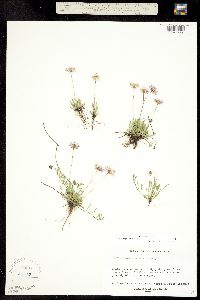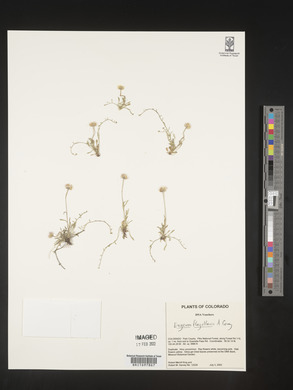Erigeron flagellaris
|
|
|
|
Family: Asteraceae
Trailing Fleabane, more...trailing daisy
[Erigeron flagellaris var. typicus Cronq., moreErigeron nudiflorus Buckl.] |
Biennuals or short-lived perennials, 3-15 cm; usually fibrous-rooted, sometimes taprooted, caudices lignescent, rarely branched. Stems first erect (greenish proximally; usually single, simple), then producing herbaceous, leafy, prostrate runners (usually with rooting plantlets at tips, populations often becoming clonal mats), strigose (often sparsely; hairs antrorsely appressed, consistent in orientation), sometimes slightly glandular distally. Leaves basal (often persistent) and cauline; basal blades broadly oblanceolate to elliptic, 20-55 × 3-9 mm, cauline abruptly reduced distally, margins entire or dentate, faces strigose, eglandular. Heads 1(-3, on proximal branches). Involucres 3-5 × 6-13 mm. Phyllaries in 2-3 series, strigose to loosely hirsute, minutely glandular. Ray florets 40-125; corollas white, often with an abaxial midstripe, often drying lilac, 4-10 mm, laminae not coiling or reflexing. Disc corollas 2-3.5 mm. Cypselae 0.8-1.3 mm, 2-nerved, faces sparsely strigose; pappi: outer of setae, inner of 10-17 bristles. 2n = 18, 27, 36, 45, 54. Flowering May-Aug(-Sep). Meadows and grassy slopes, often moist, open areas in grasslands, pinyon pine, oak-pine, pine, aspen, and spruce-fir; (1700-)2100-3600 m; Alta., B.C.; Ariz., Calif., Colo., Idaho, Kans., Mont., Nebr., Nev., N.Mex., N.Dak., Okla., Oreg., S.Dak., Tex., Utah, Wash., Wyo.; Mexico. Early season forms of Erigeron flagellaris may consist of a basal rosette and a single, erect, scapiform, monocephalous stem; leafy runners usually develop quickly. Many polyploids of this species are indistinguishable from diploids; some polyploids have features suggestive of genetic influence of E. tracyi.
FNA 2006, Kearney and Peebles 1969, McDougall 1973, Heil et al 2013 Duration: Biennial Nativity: Native Lifeform: Forb/Herb General: Biennial to perennial herbs from fibrous roots or thin, delicate taproots; plants up to 30 cm tall, strigose to hirsute with appressed hairs; the plant first produces erect stems which will eventually bear flowers, then produces sterile runners; the fertile stems are generally upright, leafy only toward the base, with flower-tipped scapes rising above the leaves; sterile stems (stolons) are usually lax, long, trailing, leafy, and often rooting at the tips. Leaves: Alternate along the stems, often also with a persistent cluster of basal leaves; lower leaves on long petioles, the blades oblanceolate, up to 2.5 cm long, with entire to dentate margins; upper leaves sessile, reduced, linear to narrowly oblanceolate, and strigose. Flowers: Flower heads showy and radiate, with white rays and yellow discs, the heads solitary on the tips of long leafless stems; involucres hemispheric, 3-5 mm high and 6-13 mm wide, the phyllaries in 2-3 subequal series, glandular and hirsute; ray flowers 40-125 per flower head, the petals 5-10 mm long and 1 mm wide, mostly white but often with a purple stripe on the abaxial (lower) surface; disc flowers yellow. Fruits: Achenes 2 nerved, sparsely hairy to glabrous; topped with a 2-layered pappus of bristles. Ecology: Found in moist areas in open coniferous forests and mountain parks, meadows and grassy slopes, grasslands,and woodlands, from 3,000-9,500 ft (914-2896 m); flowers April-September. Distribution: AZ, NM and TX, north to SD and WY Notes: Erigeron is a difficult genus, with many similar looking species distingushed from each other by subtle and obscure characters. Identify the genus as a whole from its characteristic daisy-like flowers with white to pale purple rays and yellow centers (although a few species have extremely small rays); involucres with 2-5 series of phyllaries, all about the same length (subequal); and tufts of bristles on the tops of the seeds. Compared to many other species of Erigeron, E. flagellaris is relatively easy to identify. It is quite common in some habitats, particularly Ponderosa Pine forest floors and margins of cattle tanks and other moist areas within forest habitat. Look for the daisy-like flowers on long leafless, usually upright scapes, and the leafy, sterile stems which usually run along the ground and sometimes root at the at the tips, forming new rosettes. Note that this species produces the upright fertile stems before it grows runners, so very early in the season the plants may only consist of a basal rosette and one leafless stem tipped by a single flower. E. tracyi has a similar growth form, with erect flowering stems and sterile runners, but that species tends to be more woody at the base, has denser hairs on the stems, and begins growing runners much later in the season (June). It is also somwhat unusual for the runners on E. tracyi to root at the tips. Ethnobotany: Used as a ceremonial medicine; to treat spider bites and snake bites; as an eyewash for livestock; and tied together in bunches to make brooms. Etymology: Erigeron means Early-Old-Man, as named by Theophrastus; flagellaris means whip-like. Synonyms: Erigeron nudiflorus Editor: SBuckley, 2010, Lcrumbacher, AHazelton 2017 |
|
|
|




























































































